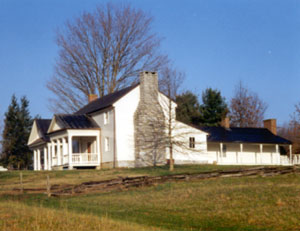
Tipton-Haynes Historic Site
The Tipton-Haynes Historic Site in Johnson City represents several eras of early Tennessee history. Woodland Period Indians and later the Cherokees frequented the area, hunting the buffalo that traveled to its natural spring. In later years, that buffalo trail became a stage road from Jonesborough, Tennessee, to Morganton, North Carolina. The site’s cave and spring attracted James Needham and Gabriel Arthur, the first white men to explore the area, as well as the long hunter Daniel Boone. The Tipton-Haynes site was purchased to preserve the Tipton-Haynes House, a residence occupied by three prominent Tennessee statesmen: John Tipton (1730-1813); John Tipton Jr. (1769-1831); and Landon Carter Haynes (1816-1875).
The elder John Tipton, a native of Maryland, purchased the site in 1784 and constructed a substantial log house. During the controversy over the State of Franklin, Tipton supported North Carolina and became an opponent of Franklin and its governor, John Sevier. In 1788 North Carolina authorities seized some of Sevier’s slaves and took them to Tipton’s house. When Sevier attempted to recover his slaves, a skirmish broke out at Tipton’s house (February 27-29, 1788) between Sevier’s pro-Franklin force and Tipton and the North Carolina supporters. The North Carolinians won this “Battle of the Lost State of Franklin,” which marked the demise of Franklin. Tipton served in the territorial assembly and as a delegate to the first constitutional convention of the State of Tennessee, created from the territory in 1796. He also served in the first and second Tennessee General Assembly.
After the death of John Tipton Sr. in 1813, his house and land became the property of his son, John Tipton Jr., a resident of Sullivan County. The younger John served in the state House from 1803 to 1815 and the state Senate from 1817 to 1819.
In 1837 David Haynes purchased the Tipton property from the heirs of John Tipton Jr. The property was then presented as a wedding gift to David’s son, Landon Carter Haynes, who added a Greek Revival portico to the house and constructed a Greek revival temple-style law office near the residence. A farmer, attorney, newspaper editor, and briefly a Methodist minister, Landon served three terms in the Tennessee General Assembly (1845-51). During the Civil War, he served as a Confederate senator from Tennessee, but his support of the Confederacy necessitated his removal to West Tennessee after the war. He died in Memphis on February 17, 1875.
John White of Washington County bought the Tipton-Haynes property at a chancery sale in 1871 and conveyed it to Sarah S. Simerly. After her death the property was inherited by her sons Samuel W. and Lawson G. Simerly, great-grandnephews of Landon Carter Haynes. In 1944 they conveyed a tract of seventeen acres and an additional tract containing the Tipton-Simerly cemetery to the state. An additional one-half acre was purchased in 1945 to complete the acquisition of what is now known as Tipton-Haynes Historic Site. The state-owned site is maintained by the nonprofit Tipton-Haynes Historical Association and was opened to the public in the early 1970s.
Suggested Reading
Dennis T. Lawson, “The Tipton-Haynes Place: I. A Landmark of East Tennessee,” Tennessee Historical Quarterly 29 (1970): 105-24; John J. Baratte, “The Tipton-Haynes Place: II. The Later Years,” Tennessee Historical Quarterly 29 (1970): 125-29



